
Germany Top Cities
On our Viking River Cruise (15-day Grand European Tour), we cruised from Budapest to Austria, and then through several towns in Germany, before disembarking in Amsterdam.
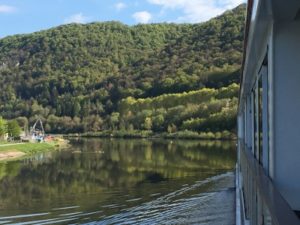

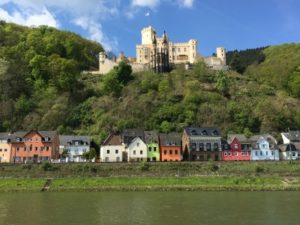
We saw scenic landscapes with castles, churches, medieval towns, vineyards along the Main-Danube Canal, Middle Rhine and Main Rivers.

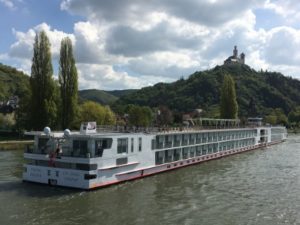

Sharing highlights from the Germany Top Cities we visited.
Top Towns in Germany
Passau, Germany:
This “Three-Rivers-City” is really one of a kind. Witness the natural wonder of the confluence of three rivers: the Danube, Inn and Ilz. The Old Town of Passau, rebuilt in the 17th century by Italian baroque masters after a devastating town fire, is rare and unique in its beauty.


In the heart of Passau rises the Cathedral of St. Steven with its three characteristic, green onion-domed towers—take in a summer concert here with music from Europe’s largest organ with its 17.974 pipes and 233 stops . Most of what you will want to see is in Passau’s Old Town—romantic cobbled lanes, window boxes, museums. Walk along the promenade to see the aged Salt Tower, the fortress “Veste Oberhaus” to the North and the Pilgrimage Church “Mariahilf” to the South high above Passau’s Old Town.



An afternoon in Scharding ~ the multi-hued pastel houses, the onion domed St. George’s Church, and the traditional German homes and farms along the water—all of these unfold before you as you traverse the quiet, emerald waters of the lesser known Inn River.

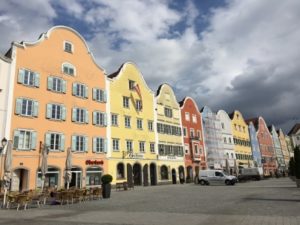

Regensburg, Germany:
Many call this city “Germany’s Medieval Miracle.” Others call it “Italy’s northernmost city.” Regensburg is Bavaria’s 4th largest city with 150,000 inhabitants and is located on the most northern point of the river Danube. As the best preserved medieval city in Germany, Regensburg presents a perfect combination impressive historic monuments and legendary Bavarian hospitality.


Here, authentic buildings of outstanding quality bear witness to the town’s political, religious and economic significance during the Middle Ages. Stroll along the narrow lanes, enjoy historical squares, imagine what life was like centuries ago, while experiencing the vibrant life of a modern city. Be sure to walk across the Stone Bridge (the oldest of its kind in Germany,) through Porta Praetoria (the north gate of the city built in the 2nd century,) spend time in St. Peter’s Cathedral (French Gothic Architecture,) and meander through the many shops and cafes. A stop at Wurstkuchl, open since 1146 AD, is well worth your time–it is the oldest public restaurant in Germany and perhaps the world—known for their bratwurst, sauerkraut and rolls made fresh daily.


Nuremberg, Germany:
An abundance of history, culture and experiences await in Nuremberg. Nuremberg Castle and Town Walls, one of the most important surviving medieval fortresses in Europe, the castle was the residence of all legitimate German kings and emperors from 1050 to 1571.


The Documentation Center Nazi Party Rally Grounds is one of Germany’s most important museum’s dedicated to the bleakest period in the country’s history–it specifically focuses on the impact of the regime on Nuremberg as well as the Nuremberg Trials that took place here after the war.


The National Germanic Museum is home to the country’s largest German art and culture collection. In Lorenzer Platz, the spectacular twin-towered 14th-century Gothic church of St. Lawrence is the city’s largest church. See its large rose window, many works of art including the Annunciation by sculptor Veit Stoss. Also nearby is the Fountain of Virtue from 1589. The Roman Catholic Gothic Frauenkirche (Church of Our Lady) dates back to 1352 and is a must-see when in Nuremberg’s Hauptmarkt. Above the porch with its rich sculptural décor is the Männleinlaufen, an old clock with mechanical figures representing the seven Electors pacing round Emperor Charles IV (performances daily at noon.) This Glokenspiel kicks off the annual Christmas festival here. Stop by a booth at the market to pick up the traditional German cookie, Lebkuchen – yum! Also, take time to visit the Toy Museum—for all ages.
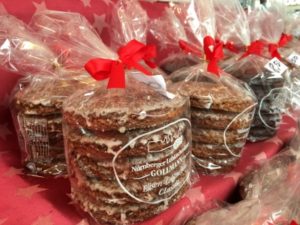



Bamberg, Germany:
This charming medieval city takes you through narrow alleys to cozy corners to amazing plazas, former residences of Prince Arch Bishops, and by nine centuries old breweries (Bamberg is known for its unique specialty: smoked beer.) If you’re shopping for a dirndl and lederhosen (traditional German dress), you’ll find some shops here.



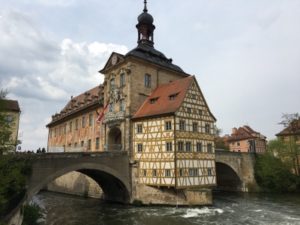
It is a city buzzing with life, students, small antique shops and beautiful Franconian countryside with opportunities for hiking, cycling and water sports.


Must-see places include the Imperial Cathedral, the Rose Garden of the New Residence (more than 4,500 roses, historic statues and a wonderful view across the roofs of Bamberg,) the Old Town Hall, built right in the middle of the River Regnitz, and the Symphony Hall (learn the history of the world-famous Bamberg Symphony Orchestra as well as enjoy its many theatres, music festivals, and music scene in jazz, blues) “Little Venice,” its promenade, family gardens and even a gondola or two fill visitors with wonder!
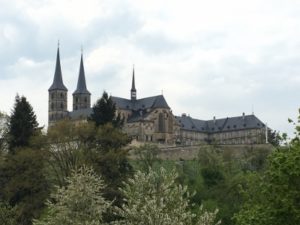



Rothenburg ob der Tauber:
We are so happy we chose to drive the Romantic Road of Bavaria to this lovingly preserved “Red Fortress above the Tauber.” It truly is the quintessential German town.


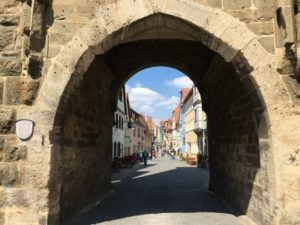
Walking the historic sturdy walls of the city offers soul filling views of the surrounding river valley villages. Rothenburg’s Town Square is surrounded by the Town Hall (Rathaus), the Clock Tower, St. Georges Fountain (circa 1608) and shops, cafes and restaurants.



We especially enjoyed the music of minstrels, the half timbered homes, a German luncheon prepared by the Familie Thurauf for 5 generations–“Glocke“–they serve bratwurst, sauerkraut, mustard, brown bread, mashed potatoes and apple strudel for dessert. Very traditional. Very yum. And if you want to buy a German Beer Stein (mug), there are plenty of shops here.




Be sure to explore the year round Christmas village (hundreds of nutcrackers, incense smokers, pyramids, swibbogen, Christmas tree ornaments, rauschgold angels, Christmas nativity scenes, many fine Christmas decorations, teddy bears, field rabbits, linens, embroidery, metal works and remembrances of Germany in each of the little shops.)


There is a strong Jewish history here as well. The St. Jakob’s Church took over 170 years to complete (1311-1484, since the Middle Ages, the Holy Blood Alter is said to contain a capsule with three drops of Christ’s blood.) There is a quiet peace here in Rothenburg that none of us wanted to leave.
Wurzburg, Germany:
Our afternoon in this ancient episcopal university town was full and sunny! It is set in the midst of an idyllic countryside of vineyards.


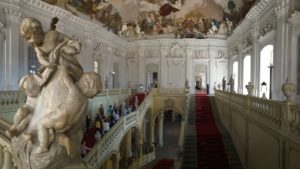
It is more than worthwhile to visit the magnificent prince bishops’ Residenz Palace (if possible—go on “Italian Night!”,) walk the water front, Old Bridge Alte Mainbrücke, from which you can see spectacular views of the fortress Marienberg and the pilgrimage church Kappele, learn the history of the Romanesque cathedral of St. Kilian, a Celtic missionary, and take in the energies of a vibrant people.

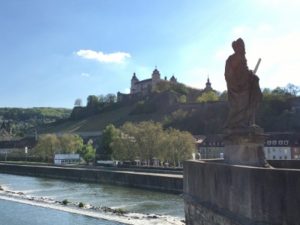

After visiting, it is not difficult to understand why Herman Hesse once wrote, “’If I could choose my place of birth, I would consider Würzburg.”
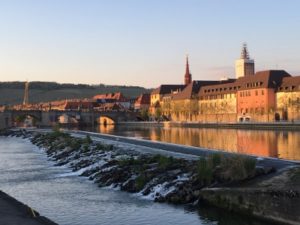
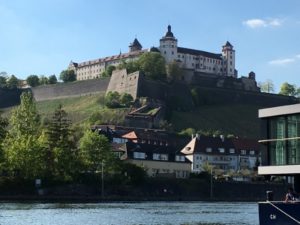
Wertheim, Germany:
Founded in the 7th and 8th century, one will find Wertheim to be a storybook setting. One will also soon discover the vitality of this strategic spot. Perhaps the most valuable things we did here were our tours with Isabel and Ursula.


From seeing the water marks of many floods (the town sits at the confluence of the Main and Tauber Rivers—guarded by its Pointed Tower,) to a visit to the Angel Fountain, to hiking the hills to the 12th Century Castle, to visiting the Glass Museum, to a sobering Jewish cemetery, walking through this historically pivotal town taught us all many life lessons.
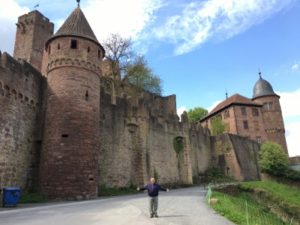

It is a quaint village with beautifully restored half timbered homes and shops, a well preserved center market with numerous guild markers full of centuries old stories about the various trades (metal crafts, butcher, cobbler, woodsman) as well as the oldest bakerie in all of Germany (be sure to ask about the mystery of the small window!) If you are fortunate, you will be there during “the time of rhubarb” as we were.
Koblenz, Germany:
“At the famous Deutsches Eck, or German Corner, where the Rhine and Moselle converge, lies one of Germany’s oldest and most beautiful towns – Koblenz. Vineyards, forests and four mountain ranges form the backdrop to the city, whose 2,000-year history has given rise to beautiful churches and castles, palatial residences and grand town houses.” Shared by our Koblenz City guide. As we cruised towards Koblenz, we saw dozens of castles!






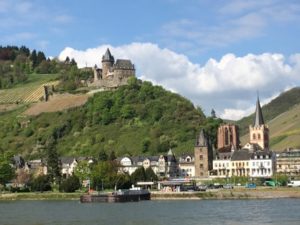
We all felt we needed more time here—but there were tremendous highlights: Marksburg Castle brought the centuries alive . . . the massive equestrian statue of Prince William I speaks of the settlement and conquests of this city (“Never will the Empire be destroyed, so long as you are united and loyal”) the Romanesque Basilica of St. Castor dates to 836 (learn about the treaty of Verdun formalizing the division of Charlemagne’s great empire,) and an afternoon visit to the centuries old Moselle south facing vineyards just as they were awakening from their winter slumber. And some of the ship’s guests choose the excursion to Marksburg Castle.


We unexpectedly came upon a monument to the tearing down of the Berlin wall—and to German unity. Three large sections of the actual wall were gifted to Koblenz as a memorial symbolizing that “as the Rhine and Moselle join, so will East and West Germany again be one.”


Cologne, Germany:
This is an intriguing city of old and new—modern and medieval cities built upon ancient Roman ruins—there are a host of activities and experiences to take in here.


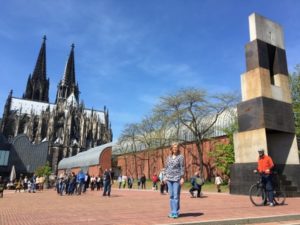
Enjoy a walking tour of Old Town, the Hohe Strasse (a pedestrian only shopping zone,) see the Heinzelmännchenbrunnen and learn the tale of Cologne’s history (and the elves that helped build the city,) visit the 18th century Residences of the Prince-Arch Bishops of Cologne, the stunning Scholosspark and the edge of the Naturpark Kottenforst-Ville nature reserve, walk the River front along the River Rhine, visit the Cologne Jewish Museum, the Chocolate Museum, the House of Fragrances, the Roman-Germanic Museum ~ take in an evening concert at the St. Martin’s Church, and enjoy lovely parks and gardens—Rheinpark is an oasis in this busy city. If you can only do one thing while you are in Cologne, be sure to visit the 14th century landmark: Koln Cathedral—it is a first rate example of Gothic artistry—one can see its twin spires for miles and magnificently detailed stained glass windows speak of Biblical days. The cathedral was built to house what are believed to be the relics of the Magi. Take time to climb the 509 steps to a 312 foot platform with astonishing 360 views. We happened to visit on the Day of Christ’s Ascension and were treated to resounding bell concerts throughout the day, including the ringing of the Pretiosa, the “Bell of St. Peter” (10.5 tons–cast in 1922 and is the largest free-swinging bell in the world.)



We took the afternoon excursion to Bonn, to visit the Brühl UNESCO Palaces where royalty, prince-archbishops of Cologne lived.



ACKNOWLEDGEMENTS
Global Adventuress would like to thank Viking River Cruises for hosting our suite on the 15-day Grand European Tour from Budapest to Amsterdam.
We had an incredible cruise and created lifelong memories with our parents, who paid for their own suite.



